Hey everyone, welcome to this week’s FutureProof, your weekly hit of tech, sustainability, and “hang on, did AI just build a power plant in orbit?”
There must’ve been something in the silicon this week because the AI news was relentless, from Apple quietly renting Google’s brain to Google itself launching a space-based AI network. (At this point, even my toaster’s probably negotiating a data-sharing agreement.)
But it wasn’t all code and chaos. Europe just locked in a 90% emissions-cut target for 2040, China’s EVs just killed its holiday petrol surge, and Australia’s giving away free solar power like it’s a door-buster sale. Oh, and Heineken’s beer is now brewed on hot bricks.
So grab a coffee (or an electrolyte drink, depending on your week) and let’s dig in.
This week’s lineup:
- Europe hits the accelerator on climate ambition
- $10 trillion says the green transition isn’t dead yet
- AI invades everything — from Siri to space
- Solar so abundant it’s literally free
- Beer brewed on sunshine and stored in bricks
As ever, FutureProof is here to prove that the future isn’t bleak, it’s just badly marketed.
These are this week’s stories:
Climate

Europe Just Hit the Climate Accelerator—90% Emissions Cut by 2040
Well now, after 15 hours of caffeine-fuelled wrangling in Brussels, EU environment ministers finally agreed to slash emissions by 90% by 2040 compared with 1990 levels. It’s not just another bureaucratic target; this one tees up a fresh climate pledge for the UN and puts Europe squarely back in the driver’s seat ahead of COP30 in Brazil. There were compromises, of course - France secured nods for nuclear, and others squeezed in a one-year delay for the carbon market on heating fuels (because voters get cranky when bills rise). Still, it’s a seismic step, one that might just reset global climate ambition, and definitely one that sets out the direction of travel allowing businesses to plan for the next 15 years accordingly.
Key Highlights:
EU agrees on a 90% emissions reduction target by 2040, paving the way for its next UN climate submission.
Carbon market delay: transport and heating fuels’ inclusion postponed to 2028 to calm price concerns.
Flexibility baked in: expanded use of international carbon credits (up to 5% of baseline emissions) and “technical neutrality” to keep nuclear on the table.
Why This Matters: If enacted, this target essentially locks Europe into a near-zero-carbon economy within 15 years - an economic, industrial, and political pivot on a scale not seen since the post-war era.
Kismet: The EU’s 90% cut by 2040 would mean its per-capita emissions fall below India’s by 2038, a staggering reversal of global carbon history. 👉 Full story here
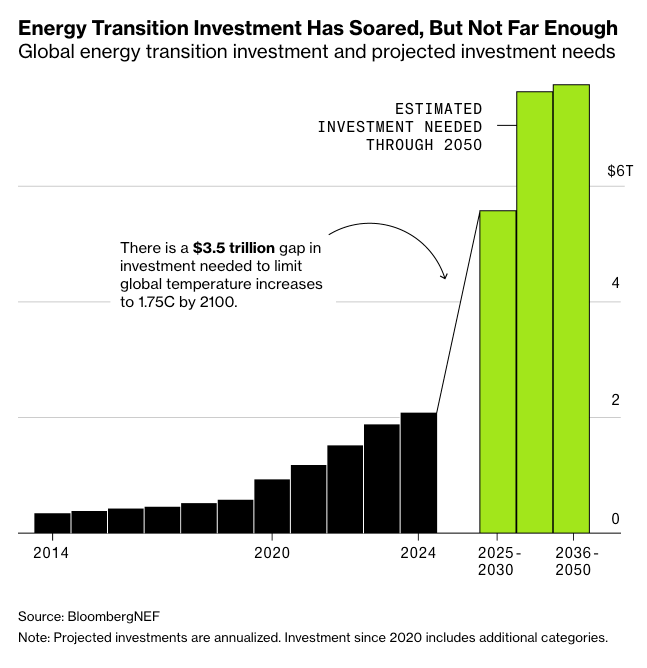
$10 Trillion Says the Green Transition Isn’t Dead Yet
Despite Trump’s tantrums, fossil-fuel lobbyists, and the usual chorus of doom, Bloomberg just dropped a staggering figure - $10.3 trillion invested in clean tech over the past decade. From solar rooftops in coal-loving Poland to electric scooters zipping through Vietnam, the world’s quietly re-engineering itself, even as global diplomacy stumbles. Yes, we’re off track for 1.5°C, but the capital markets aren’t waiting for politicians to play nice - they’re betting big on electrons, not hydrocarbons.
Key Highlights:
$10.3 trillion poured into clean technologies since 2014, with annual transition investment topping $2 trillion in 2024.
Renewables, EVs, and nuclear all booming: China now leads both clean energy deployment and nuclear build-out.
The world may finally have hit peak energy-sector CO₂ emissions - a first in human history, per BloombergNEF.
Why This Matters: Markets have made their choice. Even as political leaders waffle, the flow of trillions into green infrastructure signals that the energy transition has become unstoppable, not ideological, just inevitable.
Kismet: Vietnam, not Norway or California, is now the world’s third-largest market for electric two-wheelers, a quiet revolution humming down the streets of Hanoi. 👉 Full story here
AI News

Siri Gets a Brain Transplant—Powered by Google
Well, this is a twist for the tech ages: Apple’s new Siri will run on Google’s 1.2 trillion-parameter Gemini model, in what’s reportedly a $1 billion-a-year deal. Yes, Apple, the company that once mocked Android, is now licensing Google’s AI brains while it scrambles to finish its own trillion-parameter model for next year. The Gemini-powered Siri (code-named Linwood) will debut in spring 2026, using Google’s system for planning and summarising tasks, while Apple keeps everything walled off on its Private Cloud Compute servers. Somewhere, Steve Jobs is either applauding the pragmatism… or throwing an iPhone across the afterlife.
Key Highlights:
Apple to pay ~$1 billion annually for Google’s 1.2 trillion-parameter Gemini model to power Siri’s upgrade.
Siri’s “summariser” and “planner” brains will run on Gemini; Apple still developing its own 1 trillion-parameter AI to replace it.
The deal stays hush-hush, unlike the Google-as-Safari-search-engine partnership, and user data remains under Apple’s control.
Why This Matters: Apple’s once-smug walled garden just sprouted a big Google-shaped skylight, a rare admission that even Cupertino can’t keep pace in AI alone.
Kismet: If the numbers hold, Siri will soon run on a model nearly 8× larger than GPT-4, meaning your iPhone might soon know what you want before you’ve even finished sighing about it 👉 Full story here

Google Wants to Put AI in Orbit — Literally
Google Research just unveiled Project Suncatcher, a moonshot plan to build solar-powered satellite constellations equipped with TPUs that run machine learning models in space. The idea: harness the Sun’s constant energy and use free-space optical links to connect a swarm of mini orbital data centres, think Starlink meets DeepMind. Early tests hit 1.6 terabits per second data transfer between satellites, and radiation tests show Google’s Trillium TPUs can survive years in orbit without frying. It’s wild, it’s sci-fi, and somehow... it’s already halfway real.
Key Highlights:
Google’s Project Suncatcher envisions orbiting solar-powered TPUs connected via optical laser links for distributed AI compute.
800 Gbps each-way achieved in prototype optical links, key step toward space-based data centres.
Launch costs projected to fall below $200/kg by mid-2030s, making orbital compute cost-competitive with Earth-based centres.
Why This Matters: This could rewrite the economics of AI, infinite solar energy, no cooling issues, no land use, and latency low enough for global-scale inference.
Kismet: A single satellite in Suncatcher’s proposed orbit would receive eight times more solar power than any panel on Earth - the cosmos, it seems, makes for a very efficient data centre. 👉 Full story here

The Express Lane for Electrons — AI Meets the Grid, Finally
While Google’s dreaming of AI data centres in orbit, Emerald AI is tackling a far more immediate choke point, the grid. AI’s ravenous appetite for power is colliding headfirst with an ageing electrical system that moves slower than a government website on dial-up. Emerald’s fix? A software layer that lets data centres sync with grid conditions, ramping up when renewables abound and throttling down when supply tightens, all without frying your training run. Backed by Lowercarbon Capital, NVIDIA, and National Grid, Emerald’s “flexible compute” model could unlock 100 GW of hidden capacity in today’s infrastructure. That’s enough to power every new data centre planned this decade, without building a single new plant.
Key Highlights:
Emerald AI raises $18M (led by Lowercarbon, joined by NVIDIA, Salesforce, and others) to build flexible, grid-aware AI infrastructure.
The Aurora AI Factory in Virginia will pilot a 96-MW facility that dynamically adjusts workloads to match real-time grid supply.
Could free up 100 GW of “stranded” capacity - roughly every planned data centre for the next decade.
Why This Matters: Instead of waiting years for new substations, this turns data centres into grid allies, shaving billions off costs and accelerating renewable integration.
Kismet: A Duke study found that just a few hours of flexible throttling could unlock the equivalent of every U.S. data centre now in the queue, proving the biggest bottleneck isn’t electricity… it’s timing. 👉 Full story here

Google Maps Just Got a Brain — Meet Gemini, Your New Co-Pilot
Google’s Gemini is officially behind the wheel, and Maps may never be the same again. The new hands-free, conversational driving mode lets you chat your way through trips: “Find a vegan place with parking on my route”, done. “Add soccer practice to my calendar”, also done. The AI-powered upgrade uses Gemini’s natural language smarts and Google’s real-world database of 250 million places to serve landmark-based directions (“turn right after the Thai Siam Restaurant”), while a visual Lens + Gemini combo lets you point your phone at a café and instantly ask, “What’s the vibe inside?”
Key Highlights:
Gemini now powers voice-driven, multi-task navigation across Android and iOS, like having a chatty, capable co-pilot.
Landmark-based directions use Street View imagery to make turns intuitive (“right at the gas station,” not “500 feet ahead”).
Lens built with Gemini brings conversational local discovery - point, ask, and get real-time context about your surroundings.
Why This Matters: It’s not just navigation - it’s context-aware mobility. Gemini’s fusing spatial data and natural language to make Maps feel less like software and more like a sentient guide.
Kismet: This upgrade effectively turns Google Maps into the world’s largest AI training ground - billions of daily interactions quietly teaching Gemini how humans move, search, and decide in the real world. 👉 Full story here

Canva Just Launched Its “Creative OS” — and It’s Wildly Ambitious
Canva’s calling this its biggest launch ever, and they’re probably not exaggerating. The new Creative Operating System turns Canva from a design tool into a full-blown creative ecosystem, mixing AI, automation, and marketing tools into one platform. Highlights include Video 2.0 (a slick new editor with “Magic Video” auto-cuts), Canva Forms (data capture built right into your designs), and Canva Email Design, which lets you design and export beautiful branded campaigns in HTML. But the real showstopper is the Canva Design Model — the world’s first AI trained to understand design logic (not just generate images), capable of producing editable, layered content that actually makes sense. Oh, and they made Affinity, the pro design suite, completely free.
Key Highlights:
Creative Operating System: Unifies Canva’s tools under one intelligent platform with AI woven throughout.
Design AI: Canva’s own AI model generates fully editable, brand-aligned designs in seconds, not static images.
Canva Grow: A new marketing engine for creating, publishing, and tracking ad campaigns directly inside Canva.
Why This Matters: This moves Canva from “easy design app” to an all-in-one creative and marketing infrastructure, democratising pro-grade content creation for teams everywhere.
Kismet: Canva’s Design Model will soon integrate with ChatGPT, Claude, and Gemini, meaning your favourite AI assistants may soon literally design your next presentation, without you ever opening Canva. 👉 Full story here
Electromobility

EVs Just Killed China’s Holiday Gasoline Spike
For the first time ever, China’s “Golden Week” holiday - usually a petrol-fuelled frenzy, saw no surge in petrol demand. In fact, fuel use fell 9% year-on-year as millions of drivers took to the highways in EVs and hybrids instead. Nearly 20% of all 63.5 million trips were electric, and charging station usage jumped 46% compared to last year. With 18 million public chargers now online, long-distance electric travel is the new normal, and it’s showing up in the data: gasoline demand in China, the world’s largest oil importer, has already peaked.
Key Highlights:
Gasoline demand fell 9% in October despite record travel, a stunning reversal of decades-long trends.
EVs and hybrids made up nearly half of all new car sales this year in China.
18 million charging ports nationwide, up 55% year-on-year, made long-distance EV travel seamless.
Why This Matters: China’s shift is rewriting the global oil demand curve. When the country that once drove half the world’s fuel growth starts going electric en masse, it’s not a blip, it’s a tipping point.
Kismet: China’s EV fleet now displaces so much petrol that one week of holiday driving saved roughly 1 million barrels of oil, equivalent to grounding every domestic flight in the U.S. for a day. 👉 Full story here

I rarely use public chargers to charge my car (I’ve only needed to twice in the last 12 months), but last Saturday when I was at a public charger, this full EV big rig pulled in alongside me to charge. It is owned/operated by a 3PL company here in the South of Spain called Nistics, which has a fleet of EV class 8 trucks.
Clean Energy
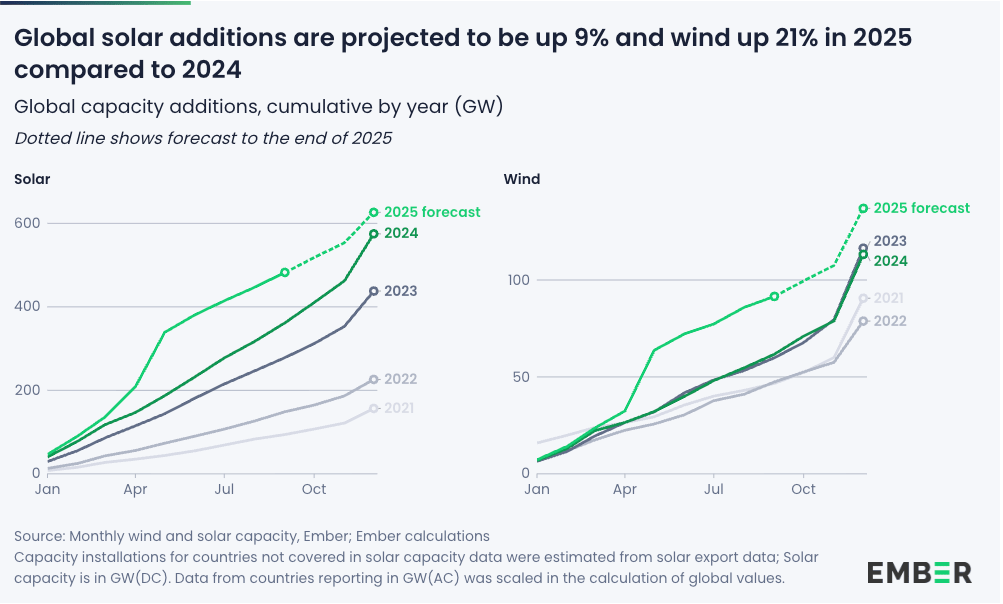
The Solar Surge That’s Bringing the 1.5°C Goal Back Within Reach
Fresh data from Ember’s 2025 renewables report shows the world adding a record 793 GW of new renewable capacity this year, a mind-bending 11% jump that puts the COP28 pledge to triple renewables by 2030 “within reach.” Solar alone has quadrupled since 2021, with China installing two-thirds of all new global capacity. The world’s now building clean power faster than required, averaging 29% annual growth since 2023, meaning we only need 12% yearly growth to hit the 2030 tripling target. The catch? Governments’ official national targets are still lagging, they only plan for a doubling, not a tripling, leaving grids, storage, and wind deployment undercooked.
Key Highlights:
2025 renewable capacity additions hit 793 GW, up 11% from 2024, led by solar (+9%) and wind (+21%).
China dominates: 66% of solar and 69% of wind capacity added globally this year.
To hit the tripling target (11 TW by 2030), we now only need 12% annual growth, entirely doable if policy keeps pace.
Why This Matters: The planet’s on the cusp of its biggest-ever clean energy breakthrough, but without stronger national targets, politics could bottleneck what physics and engineering have already made possible.
Kismet: Solar alone now adds more capacity each year than every other power source combined, a first in energy history, and a clear sign the fossil era’s sunset is officially well underway. 👉 Full story here

Australia Just Made Power Free — Because It Has Too Much Solar
Here’s a sentence that would’ve sounded like satire ten years ago: starting next year, Australians will get three hours of free electricity every afternoon, no solar panels required. The new “Solar Sharer” program mandates that energy retailers pass along the savings from mid-day solar oversupply, when wholesale electricity prices routinely go negative thanks to record solar penetration. People can run laundry, dishwashers, EV chargers, or pool pumps for free, or charge home batteries to use later. It’s not a stunt. It’s policy born from abundance: Australia now produces so much cheap solar power it’s literally giving it away - which is far better than the alternative - curtailing it.
Key Highlights:
“Solar Sharer” policy: every household gets 3 hours of free power per day starting 2026, nationwide by 2027.
Enabled by record solar overproduction, which pushes wholesale prices below zero during midday hours.
Expected to reduce peak demand and accelerate adoption of batteries and smart appliances.
Why This Matters: This isn’t a rebate, it’s the future. A country so rich in solar energy it’s making electricity a public good, not a luxury.
Kismet: Australia’s solar fleet now produces 60 GWh of surplus electricity every sunny day between noon and 3 p.m., twice Ireland’s entire daily consumption, proving abundance isn’t a theory, it’s grid reality. 👉 Full story here
Storage

Fatih Birol: Batteries Are the New Oil — and China Owns the Well
In a rare and blunt warning, Fatih Birol, Executive Director of the IEA, says batteries have become “one of the most important technologies of the 21st century”, and the world’s dependence on China for them is alarmingly similar to Europe’s pre-Ukraine reliance on Russian gas. Writing in the Financial Times, Birol notes that China now controls virtually every step of the global battery value chain, from critical minerals to gigafactory output, producing six times more batteries than the U.S., and more around Shanghai alone than all of Europe combined. Batteries now underpin everything from EVs and grid storage to AI data centres and drones, with 130 GW of new storage to be added globally this year, more than the world’s biggest-ever annual addition of gas power.
Key Highlights:
Global battery prices have fallen over 90% since 2010, turbocharging electrification and energy storage.
China dominates: controls nearly all grid battery production and most supply of critical minerals.
Battery storage additions this year (130 GW) exceed all gas-fired power added in any year in history.
Why This Matters Batteries are the linchpin of the energy transition, for EVs, renewables, AI, and defence, yet the supply chain remains dangerously concentrated. Diversifying it isn’t just climate policy; it’s economic and national security strategy.
Kismet: The Shanghai region alone now churns out more batteries than the entire European continent, a reminder that whoever leads in batteries may well lead the 21st-century economy itself. 👉 Full story here

Cold Beer, Hot Bricks — Heineken Just Ordered a 100 MWh Battery Made of Fire
I mentioned Rondo Energy in last week’s newsletter, and they’ve only gone and done it again! Rondo announced their second 100 MWh “heat battery” project in just weeks, this time brewing sustainability in Portugal with Heineken and EDP. The Vialonga brewery near Lisbon will use Rondo’s refractory-brick battery to store cheap solar electricity as heat (up to 1,500 °C!) and then use it to produce renewable industrial steam 24/7, cutting gas use, emissions, and price volatility. A 7 MW solar plant on-site will feed the system with 25 GWh a year of sunshine-powered electrons, turning beer brewing into a zero-carbon process that’s as efficient as it is poetic.
Key Highlights:
100 MWh Rondo Heat Battery to provide continuous renewable steam for Heineken’s Lisbon brewery.
Backed by EDP’s 7 MW solar PPA, delivering 25 GWh/year of clean power to charge the system.
Technology achieves 97% round-trip efficiency, storing heat up to 1,500 °C for hours or days.
Why This Matters: Industrial heat is one of the hardest decarbonisation frontiers, and Rondo’s brick batteries are quietly proving it’s not just solvable, it’s scalable.
Kismet: This single system will displace as much gas as 10,000 Portuguese homes use each year, all while keeping the beer cold and the bricks hot, the kind of circular logic (and beer!) I can get behind. 👉 Full story here
Latest blog post

How SMEs Can Drive Sustainability with Telematics
In my latest blog post, I argue that the sustainability revolution in transport isn’t being led by BYD or Toyota, it’s being driven (literally) by plumbers, electricians, and delivery drivers. Small and medium-sized enterprises (SMEs) make up 90% of all businesses globally, yet they’ve historically been shut out of fleet tech. Now, affordable plug-and-play telematics, once exclusive to logistics giants, is democratising data and delivering immediate results: up to 15% less fuel, 30% less idling, and 40% fewer collisions (and so lower insurance premiums).
This isn’t just about cutting costs; it’s about data equity. When SMEs gain visibility into how they drive, they become full participants in the climate transition, not passive observers.
Key Highlights:
SMEs adopting telematics cut fuel use by up to 15% and save ~1.6 t CO₂ per vehicle per year.
Driver behaviour tracking and dashcams reduce collisions by 40%+ and lower insurance claims.
Global telematics market to triple to $168B by 2030; small fleets are finally joining the digital mainstream.
Why This Matters: If every SME fleet cut emissions by just 10%, we’d erase 120 million tonnes of CO₂ annually, equal to the entire transport output of Spain and Portugal combined.
Kismet: A Linxup customer drove 6% more miles on 9% less fuel, a paradox only data could make possible, and proof that smart fleets don’t just drive cleaner; they drive wiser. 👉 Full story here
Climate Confident:

Why Microgrids Might Beat Hydrogen in the Race to a Clean Grid
In this week’s Climate Confident episode, I sat down with Rinaldo Brutoco, founder of the World Business Academy, and let’s just say he doesn’t do half measures. Rinaldo argues that California could replace 100% of its fossil fuel use in under a decade, at lower cost, by deploying solar-fed fuel-cell-supported microgrids, no mega-utilities, no politics, just distributed resilience. We talked about how business, not government, might be the only institution nimble enough to handle climate chaos. And yes, we touched hydrogen, where I share my scepticism. As I pointed out, 95% of hydrogen today is fossil-based, and “green” hydrogen still faces brutal distribution and cost hurdles. Rinaldo’s optimism is contagious, but I can’t help feeling the hype often races ahead of the economics.
Key Highlights:
Microgrids could replace the centralised grid, cutting costs, fire risk, and outages in one stroke.
Fuel-cell systems at substations could enable local, resilient power generation without blackouts.
Hydrogen remains a long shot: 95% of supply is grey, transport infrastructure barely exists, and costs remain stubbornly high.
Why This Matters: As we scramble for decarbonisation tools, it’s worth asking whether we’re chasing flashy new fuels when smarter use of electricity itself might do the job faster, cheaper, and cleaner.
Kismet: California utilities admit the grid could collapse irreparably within six months of major failure, meaning local generation isn’t just resilience, it’s survival. 🎧 Listen to the full episode
Resilient Supply Chain:
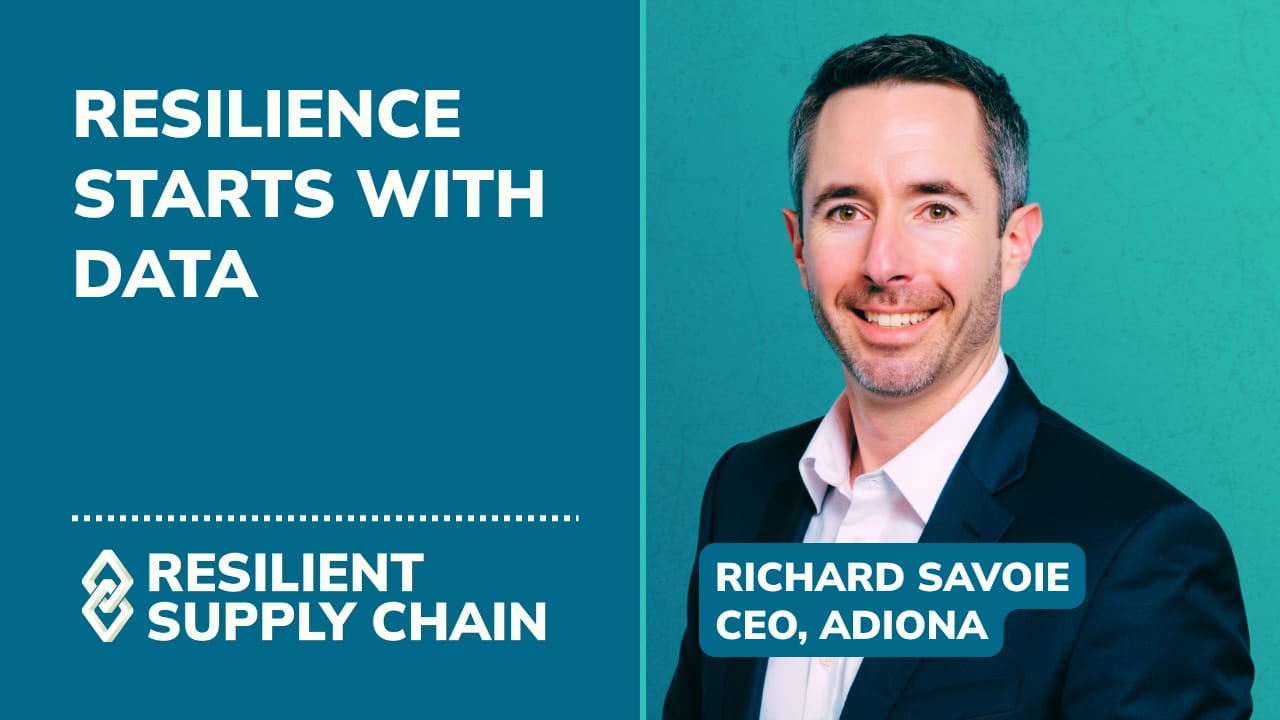
The Future of Delivery Is Resilient, Not Just Sustainable
The newly rebranded Resilient Supply Chain Podcast kicked off with a bang, and a brainy guest. I sat down with Rich Savoie, CEO of Adiona, whose AI-driven optimisation platform is quietly redefining last-mile logistics. His team helped Coca-Cola and Australia Post cut drive time by nearly half, yes, half, simply by letting data do what diesel never could: think. We unpacked how smarter routing, EV-ready fleet design, and human-centric AI can make delivery networks leaner, cleaner, and actually kinder to the people who run them.
Key Highlights:
Adiona’s AI helped a national fleet cut drive time by 48%, kilometres by 36%, and truck count by 15%.
Commercial vehicle electrification delivers the biggest emissions bang for the buck, but only with proper route and load analysis.
Humanistic AI, algorithms that simplify drivers’ lives, turns efficiency into wellbeing.
Why This Matters: Supply chains can’t be sustainable if they exhaust people, fuel, or data. Optimisation isn’t just efficiency, it’s empathy at industrial scale.
Kismet: Australia Post found the best optimisation tech in the world in its own backyard, proof that resilience sometimes begins right where you stand.
🎧 Listen to the full episode
Coming Soon to the podcasts
In the coming episodes I will be talking to Honeywell’s Taylor Smith, Peak Tech’s Elton Saunders, and Addison Stark, CEO of AtmosZero.
Don’t forget to follow the podcasts in your podcast app of choice to ensure you don’t miss any episodes.
Featured Chart(s)

If you ever hear anyone saying that climate change is an issue of over-population, show them this chart. I mean, to an extent they are correct, eliminate the world’s wealthiest 10% of people, and you cut emissions by 48%!
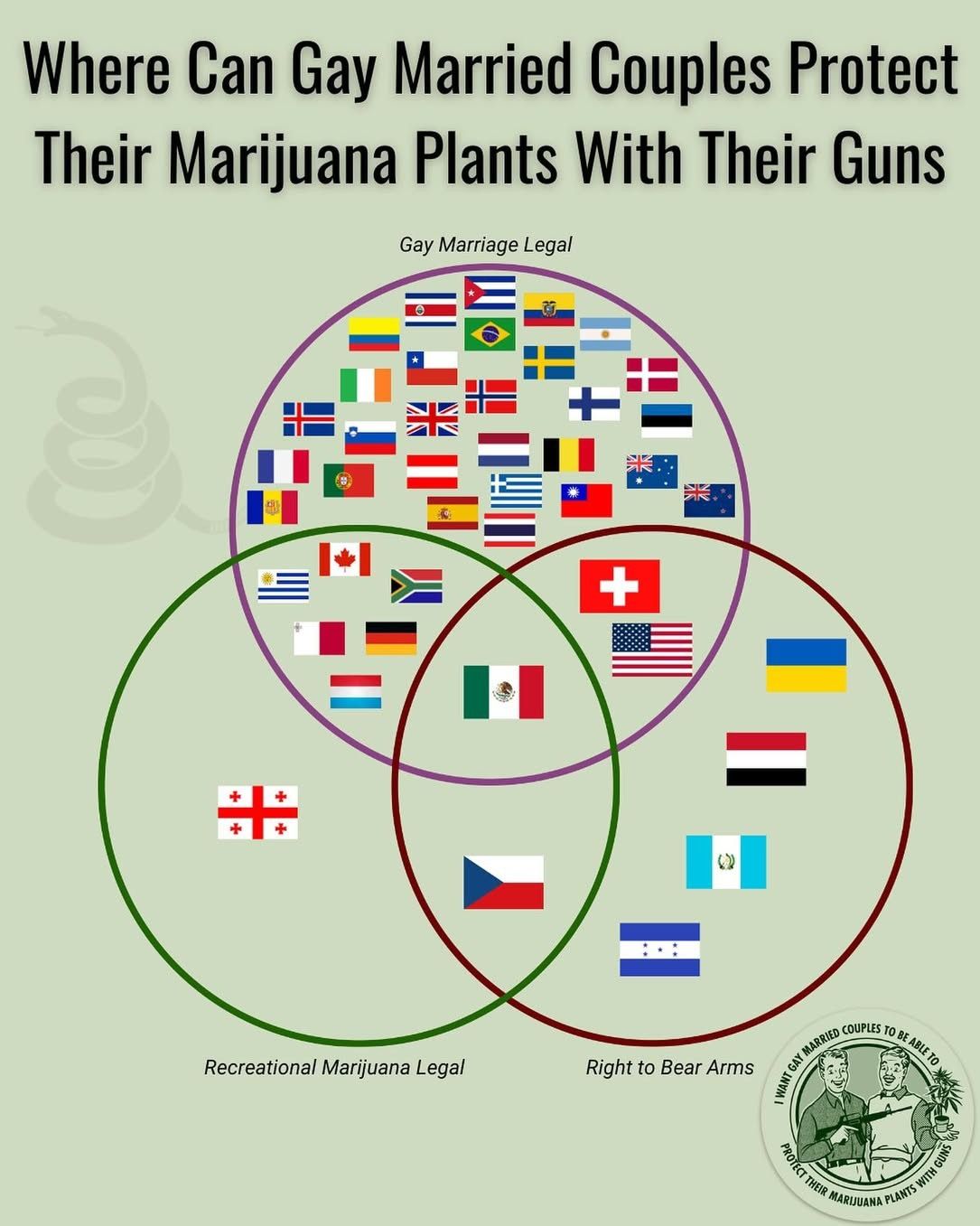
This one is purely tongue in cheek.

As is this one!
Misc stuff
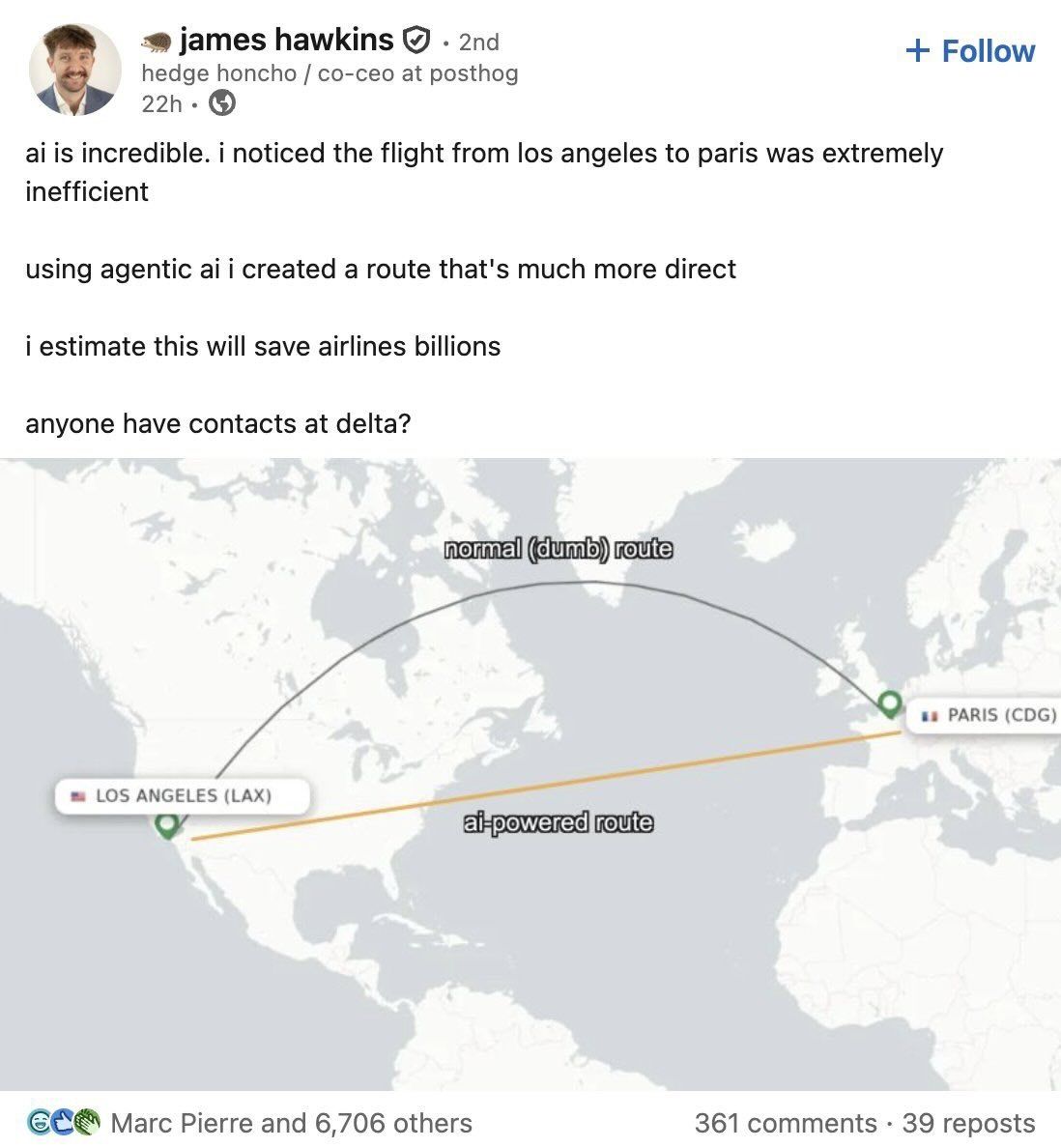
Who’s going to tell him?
Engage
If you made it this far, very well done! If you liked this newsletter, or learned something new, feel free to share this newsletter with family and friends. Encourage folks to sign up for it.
Finally, since being impacted by the tech layoffs, I'm currently in the market for a new role. If you know someone who could benefit from my tech savvy, sustainability, and strong social media expertise, I'd be really grateful for a referral.
If you have any comments or suggestions for how I can improve this newsletter, don’t hesitate to let me know. Thanks.
*** Be aware that any typos you find in this newsletter are tests to see who is paying attention! ***
And Finally
I’m so happy I’m a native English speaker. If I had to learn it as a second (or third, or…) language, I think I’d lose my mind completely!
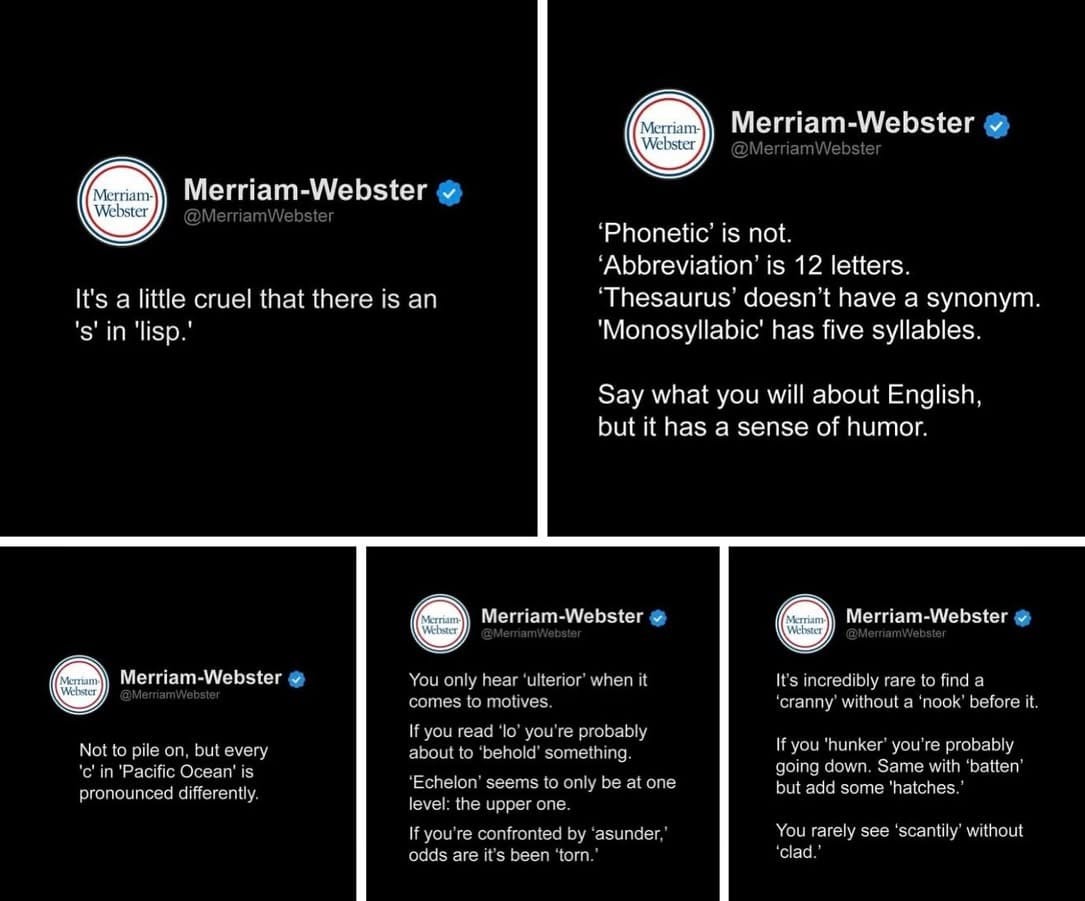
Find customers on Roku this holiday season
Now through the end of the year is prime streaming time on Roku, with viewers spending 3.5 hours each day streaming content and shopping online. Roku Ads Manager simplifies campaign setup, lets you segment audiences, and provides real-time reporting. And, you can test creative variants and run shoppable ads to drive purchases directly on-screen.
Bonus: we’re gifting you $5K in ad credits when you spend your first $5K on Roku Ads Manager. Just sign up and use code GET5K. Terms apply.


